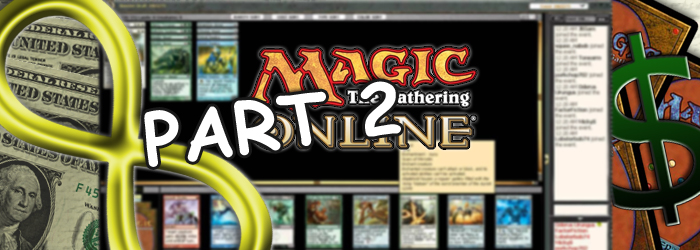
Today, we’re picking up where we left off last time, with rules six through ten of my 10 rules for profit. Check out last week’s post for rules one through five.
Rule #6 – Understand Estimated Value (Don’t Play 4-3-2-2)
When it comes to prizes, the 4-3-2-2 format has the very worst payout for the cost. While it feels like it is a small step up from Swiss, it is actually a step down. In Swiss, three of the four players that lose the first round will get prizes. If you are confident that this won’t be you, then you should be playing 8-4s. In an 8-4, if you get to the finals, you’ll pull down a significant number of packs. If you can’t make it to the finals on a regular basis, you’ll do better in Swiss. There are only 11 prize packs in a 4-3-2-2 as opposed to 12 in both Swiss and 8-4. If you’re good enough to get into the top 50%, you’re better off competing over 12 packs than 11.
It is the Limited community’s hope that someday 4-3-2-2s will become 5-3-2-2s (we now see this in Constructed queues), which would be awesome. But until this happens, friends don’t let friends play 4-3-2-2s. Each time you do, you are giving up about .37 tix. This means that instead of paying 11 tix to play you’re paying 11.37 tix. It adds up the more you play, but the most important reason not to play 4-3-2-2s is that if people stop playing, WOTC will have to make the prize structure worth it – some day.
Rule #7 – Selling Cards in Multiples is Easier
With the exception of really expensive cards, playsets of cards worth .25 to four tix are far easier to sell than single cards. A player looking for an [card]Imposing Sovereign[/card] is more likely to need four. Many would rather pay six tix for the playset than try to work out deals with multiple dealers to end up paying 1.25 tix each. After all, if you pay 1.25 from four different bots, it will end up costing you eight tix and you’ll be stuck with .75 credit at four different stores. Better to buy and sell in multiples. It tends to take less time and draw more interest from buyers. Plus, if someone needs one of a card you’re selling as a playset, they are still likely to contact you.
Selling multiples also gives you more control over the price of your cards. If I’m trying to sell off my playset of [card]Heliod, God of the Sun[/card], I can price the cards at 2.5 each by selling the set for 10 tix, or I can set the price at 2.75 and sell the set for 11 tix. If I’m trying to sell cards individually, my only real options are two or three tix, because trying to work out trades for .25 tix can be a real pain.
Rule #8 – Understand How Bots Work
The MTGO classfied ads are filled with a large number of automated stores called bots. Most bots offer buying, selling, and trading functions. If you purchase a card worth .5 tix, a bot will save your leftover credit for a later purchase or to pay you back on a future sale. I’ve learned the hard way that .25 tix in credit stored on four different bots is not the same thing as having a ticket in your hand.
It is important to pay attention to how much you’re paying a bot for a card. Bots will sometimes price cards at odd numbers like 1.002, .667, or .502 tix. This means if you want to purchase cards, even multiples from them, you’ll end up having to pay an additional ticket and get something like .992 credit. Sometimes this isn’t a big deal, as you can spin off a handful of commons to make up the difference. But sometimes the “great deal” you just found ends up costing you more than you intended to pay. If you’re purchasing at prices like this, you’re better off doing so at more established stores such as MTGO Traders or Supernova Bots, because you’re likely to find a good use for the credit.
Don’t forget to add any bot that owes you credit as a buddy. I don’t know how many times I’ve traded with a random bot and found credit I’d forgotten about. It is also probably worth keeping a log of how much credit bots owe you. Once you start trading with bots, it’s almost impossible to get your credit down to zero. If I find myself close to a full ticket in value on a bot I’ll generally open up my entire collection as tradeable and see if there’s anything I can let go for a couple cents to bring the balance up and get a ticket.
If you ever have a full ticket in credit, take a ticket instead of leaving the credit. Also, be weary of bots with good prices and no tickets available to trade. It doesn’t matter if you get 25 credits for a 10-ticket card if the bot charges one credit for commons.
Rule #9 – Learn What Bulk Means
Bulk rares on MTGO generally cost around .05 tix, but can only be sold for around .01. Sometimes bulk rares will take off and gain some value, but these are the exceptions. This means that you can put together a very playable non-net deck for just a couple of tix. But those values won’t go anywhere – most of the time. When they do, you’ll see massive profits, but this can be very difficult to predict. I suggest listening to Marcel and the other guys on the Brainstorm Brewery Podcast for ideas about what bulk rares have the potential to go off. But otherwise, be very careful about dropping money into bulk rares.
Rule #10 – Set a Goal
Having a goal really helps you reach for something. As a school teacher, I’ve noted that nothing drives a student to success as much as when he sets his own goals and then strives to reach them. My first goal on MTGO was to get enough money to play in a Draft. I started with an initial two tix, two packs, and a handful of mostly-worthless cards. To make a Draft happen, I needed to turn my starting set into another pack. With only two tickets this was a significant challenge. Some of the first trades I made included buying copies of Magic 2011 [card]Time Spiral[/card] for .9 tix from one bot and selling them for one ticket to another bot. The first bot had enough available that I was able to gain a ticket through buying and selling 10 copies of [card]Time Spiral[/card].
After I played in a few Drafts, I decided to set a new goal. I wanted a full set of Magic 2012. The idea of paying $5 for a full set of cards sounded great to me. So I began to work toward this goal. It took me over a year to complete, but without spending any additional cash, I was able to put together an entire set of Magic 2012 for redemption. After completing this set, I took a break.
My next goal was formed when I saw a Facebook post that my best friend and first Magic opponent from middle school, David Guskin, was the lead developer for Magic 2014. Given our history, I felt like I owed it to him to play the set that he could call his. I could see a number of elements included in the set that reminded me of how we used to play back in the day, so I decided I wanted to build a complete set. This was just before the prerelease and I had a glorious two tix in my account. I set the goal of playing a release sealed queue at a 26-ticket entry fee. It took me a couple weeks, but by selling off uncommons and commons, as well as buying and selling rare lands, I was able to get the tickets together. I managed to place second in the one I played. All in all, 26 tickets bought me a [card]Liliana of the Dark Realms[/card], an [card]Imposing Sovereign[/card], and a [card]Witchstalker[/card], as well as eight packs of M14. I was on my way to my goal.
When you have a goal, you have a reason to come back. By having something left incomplete, you will be drawn to return. If you don’t have a goal, you won’t have anything to do at a given time. Maybe you want to create a cool EDH deck or make your current one all foil. Maybe you want a playset of a 30-ticket card or you want to move in on that new Standard deck. Setting goals is what drives us to better ourselves. I can’t tell you what a good goal for you will be, but I know that without one you are much more likely to quit.
Conclusion
Many of these rules will surely end up with their own post at some future point, going into further detail of why and how they are best observed. However, rule #1 (pennies matter, don’t give them up) is the most important and will be a running theme in all my articles. In order to play infinitely, you can’t look at .5 tix and consider it nothing. It is half a ticket, 1/7th of a pack, 1/25th of a draft. If you can squeeze .33 tix out of a trade three times, it is money in the bank. Use these rules to help you play smarter and eek out an edge. Playing infinitely is all about not giving up free money and taking every advantage you can get.
Have comments? Please post below!
4 comments on Marc DeArmond – Casually Infinite: 10 Rules for Profit, Part Two
Leave a Reply to Reader Cancel reply
You must be logged in to post a comment.

A note on rule 6:
If 8-4s are available then 4-3-2-2s should always be avoided. With that said, if for some reason you have a choice between 4-3-2-2s and Swiss (because, for example, 8-4s aren’t offered or flat aren’t firing) then there’s a win rate where 4-3-2-2s are better value than Swiss despite the pack difference.
I covered the EV of draft formats in length here: http://brainstormbrewery.com/matt-crocker-dealing-with-draft-addiction/
The 4-3-2-2 is also the biggest talking point for everyone ever to co-host the pod cast Limited Resources. Marshal’s rants are becoming entertaining on the subject. He keep trying to stretch what English, as we speak it, as spoken by us, can say on how bad value they are.
That’s because Marshal and his co-hosts are all people who are good at math. 4-3-2-2s are like the lottery: they are a tax on people that are bad at math.
Why am I wasting my time reading an article from a guy who wastes time for fractions of a ticket? This site is a joke.